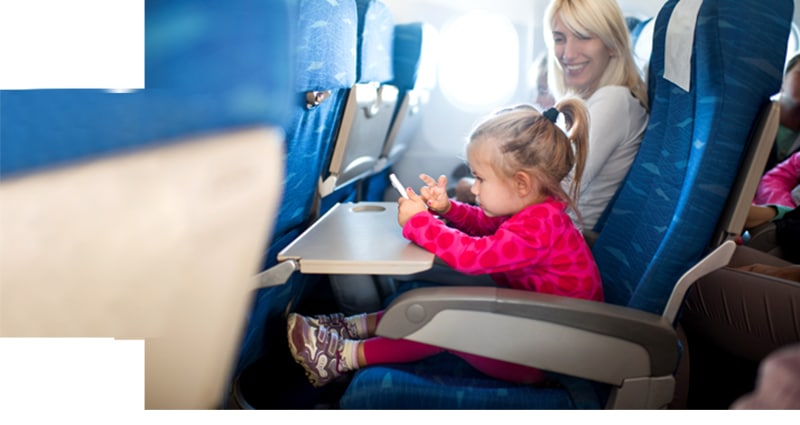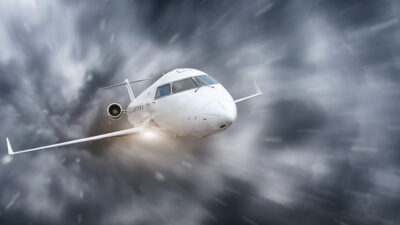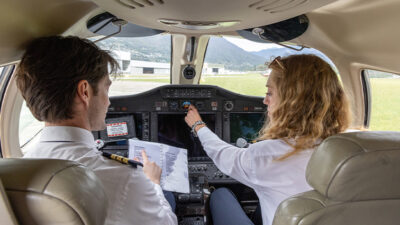Medical Advisory: Safe Sleeping, Best Seats and More Safety Tips for Air Travel with Children

Let’s face it, traveling with children can be stressful. Whether on a commercial aircraft or a private flight, one of the most challenging times is when a child becomes unwell during flight. And with summer travel approaching, it’s important to remember that children are not immune to in-flight medical events.
MedAire, the world’s leading provider of in-flight medical advice and assistance, analyzed more than 114,000 onboard medical incidents over a five-year period. They found the most common injuries experienced by the children affected were burns—mostly caused by spilled hot beverages or soups—and contusion and lacerations following falls from seats.
The good news is that there are some simple things parents can do to prevent or reduce in-flight illness and injury. The following recommendations will help keep children safe and flights uneventful:
Healthy for Travel. Ensure children are healthy for travel. Discuss any pre-existing conditions or health issues with your pediatrician prior to traveling. If your child has been sick, or becomes sick at the time of departure, share your concerns with a gate agent so a proper assessment can be made prior to take off. Taking a preventive approach on the ground will avoid an in-flight emergency where options are limited. Using disposable wipes to wash little hands and clean off seat back trays will help prevent the spread of germs.
Come Prepared. The most common in-flight ailments for infants and children are gastrointestinal and respiratory related. Parents should travel with their own supply of common medications such as analgesics, antihistamines, and antiemetics should they be needed in flight. Always keep these medications in your carry-on luggage, keeping in mind you will need travel-sized bottles for liquids to meet TSA guidelines. Packing some healthy snacks is always a good idea, too.
FAA Approved Child Restraint System. If you can afford it, you should consider purchasing an infant seat rather than have them travel as a lap infant. The safest option is to have a child secured using an FAA approved child restraint system (CRS) at all times. Use the CRS beyond takeoff and landing to avoid common injuries such as falling from a parent’s lap or into the aisle.
Location, Location, Location! Choosing the right seat is important too. If that extra seat isn’t an option, the next best choice is a window or middle seat as many in-flight injuries occurred when items fell from overhead bins: children fell into the aisle, collided with other passengers or the food/beverage meal cart; or hot liquids were spilled being passed over other passengers. Keeping infants and toddlers away from the aisle can reduce risks of common injuries.
Take Turns. Take turns keeping children occupied. If there is more than one adult traveling together, take turns staying vigilant to ensure the safety of the child while the other adult rests. The longer the flight, the more restless the child will be. Bring age-appropriate books, quiet toys or movies (with child-sized headphones) to keep children occupied in their seat, keeping in mind that you should minimize the time that they are not using a restraint.
Practice Safe Sleeping. While it may seem obvious, the same safety risks that apply at home apply in the sky. Always practice safe infant sleeping wherever you are, as suffocation and SIDS-related (sudden infant death syndrome) fatalities can occur anywhere. Be careful to ensure that your lap baby is not overdressed or overheated on the plane, allowing for good ventilation when sleeping on a parent. Conversely, watch to make sure they don’t have vented air blowing directly on them.
Stay Calm. If you do have an emergency, stay calm and rest assured knowing that help is available. Ask the flight attendant or other crew members for assistance as soon as you identify any health concerns. It is never too early for you to bring up a medical concern. In fact, the earlier it can be addressed, the better. Airlines and private aviation companies have protocols to help passengers when health incidents occur onboard. The flight crew is trained in first aid and knows what to do to help in an emergency, often utilizing remote medical assistance from emergency health care providers on the ground that can advise and assist.
About the Research
MedAire’s world-renowned aviation medical expert, Dr. Paulo Alves, Global Medical Director, Aviation Health and Group Medical Director of International SOS, and Dr. Neil Nerwich, in collaboration with Dr. Alexandre Rotta and the University Hospital Rainbow Babies and Children’s Hospital in Cleveland, examined MedAire’s extensive database of in-flight medical events (IFME).
The research evaluated over 114,000 IFMEs that occurred between January 2009 and January 2014. More than 10% of these events involved children (newborn to age 18). While the vast majority of cases involving children requiring medical help were the result of a pre-existing medical condition or health problem, more than three percent of cases involved an injury occurring during the actual flight. Of those cases, 35% involved children under the age of two.

Flight departments around the world rely on MedAire, an International SOS company, to reduce their travel safety risks. Crews are trained on the resources to manage in-flight illness and injury with onboard medical equipment and telemedicine assistance. On the ground, passengers and crew have one resource for medical referrals; guaranteed payments for medical expenses; assistance with lost documents and prescriptions; online and e-mail travel advisories; evacuation support and a host of other services.
http://www.medaire.com/
© 2024 MedAire Worldwide. All Rights Reserved.
Next ArticleRelated Posts

Understanding the Challenge of Turbulence-Related Injuries in Business Aviation
The challenge of managing air turbulence in business and private aviation is becoming increasingly evident due to the growing number of turbulence-related incidents affecting aircraft operators across the industry.

Safety in Numbers: Trends in Aviation Accidents and Incidents
Every accident is preventable; the problem is that we don’t know how to prevent it until after the accident happens. However, what we can do as an industry is honor the anguish of each event by sharing the information, the mistakes and the outcomes to improve safety for everyone.

